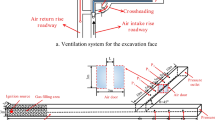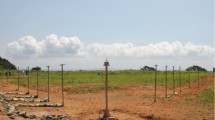Abstracts
In this paper, a three-dimensional simulation has been performed to investigate the potential consequences of flammable vapor explosion in a tunnel with an obstacle, the obstacle with different area blockage ratios (10, 20, 30 and 40%). The blast wave shape, increase in the maximum explosion overpressure, and the arrival time of peak pressure in the vicinity of the obstacle with different blockage ratios have been characterized. The simulation results show that the configuration of the blast wave was remarkably compressed due to the effects of obstacle and the deformation process which can be divided into four stages. The influence of blockage ratio on the maximum overpressure and the arrival time of peak pressure were mainly reflected in the back of the obstacle 1 m from the ground, and the maximum overpressure for this location decreases as the blockage ratio increases. Meanwhile, the maximum overpressure of 10% blockage ratio is 57% higher than that of 40% blockage ratio for the location of the back of obstacle. The arrival time of peak pressures for the location of the back of obstacle is delayed as the blockage ratio increases. The maximum overpressure under the tunnel ceiling showed an opposite trend between the location of the front of the obstacle and the location behind the obstacle. In the front of the obstacle, the maximum overpressure under the tunnel ceiling increases as the blockage ratio increases; however, it decreases as the blockage ratio increases in the back of the obstacle. What’s more, the comparison of this paper’s data and the results from available are published. It was found that the simulation results in this article are consistent with the experimental results of studies.













Similar content being viewed by others
References
Anguera R. The channel tunnel—an ex post economic evaluation. Transp Res Part A: Policy Pract. 2006;40(4):291–315. https://doi.org/10.1016/j.tra.2005.08.009.
Abdel-Raheem MA, Ibrahim SS, Malalasekera W, Masri AR. Large eddy simulation of hydrogen–air premixed flames in a small scale combustion chamber. Int J Hydrogen Energy. 2015;40(7):3098–109. https://doi.org/10.1016/j.ijhydene.2014.12.042.
Ji J, Li LJ, Shi WX, Fan CG, Sun JH. Experimental investigation on the rising characteristics of the fire-induced buoyant plume in stairwells. Int J Heat Mass Transf. 2013;64:193–201. https://doi.org/10.1016/j.ijheatmasstransfer.2013.04.030.
Fan CG, Ji J, Gao ZH, Han JY, Sun JH. Experimental study of air entrainment mode with natural ventilation using shafts in road tunnel fires. Int J Heat Mass Transf. 2013;56(1–2):750–7. https://doi.org/10.1016/j.ijheatmasstransfer.2012.09.047.
Gao W, Zhang X, Zhang D, Peng Q, Zhang Q, Dobashi R. Flame propagation behaviours in nano-metal dust explosions. Powder Technol. 2017;321:154–62. https://doi.org/10.1016/j.powtec.2017.08.013.
Molkov V, Verbecke F, Makarov D. LES of hydrogen-air deflagrations in a 78.5-m tunnel. Combust Sci Technol. 2008;180(5):796–808. https://doi.org/10.1080/00102200801893994.
Rosas C, Davis S, Engel D, Middha P, van Wingerden K, Mannan MS. Deflagration to detonation transitions (DDTs): predicting DDTs in hydrocarbon explosions. J Loss Prev Process Ind. 2014;30:263–74. https://doi.org/10.1016/j.jlp.2014.03.003.
Ji J, Gao ZH, Fan CG, Zhong W, Sun JH. A study of the effect of plug-holing and boundary layer separation on natural ventilation with vertical shaft in urban road tunnel fires. Int J Heat Mass Transf. 2012;55(21–22):6032–41. https://doi.org/10.1016/j.ijheatmasstransfer.2012.06.014.
Cao X, Ren J, Zhou Y, Wang Q, Gao X, Bi M. Suppression of methane/air explosion by ultrafine water mist containing sodium chloride additive. J Hazard Mater. 2015;285:311–8. https://doi.org/10.1016/j.jhazmat.2014.11.016.
Koutsourakis N, Venetsanos AG, Bartzis JG. LES modelling of hydrogen release and accumulation within a non-ventilated ambient pressure garage using the ADREA-HF CFD code. Int J Hydrogen Energy. 2012;37(22):17426–35. https://doi.org/10.1016/j.ijhydene.2012.05.146.
Gao W, Mogi T, Yu J, Yan X, Sun J, Dobashi R. Flame propagation mechanisms in dust explosions. J Loss Prev Process Ind. 2015;36:186–94. https://doi.org/10.1016/j.jlp.2014.12.021.
Middha P, Hansen OR. CFD simulation study to investigate the risk from hydrogen vehicles in tunnels. Int J Hydrogen Energy. 2009;34(14):5875–86. https://doi.org/10.1016/j.ijhydene.2009.02.004.
Baraldi D, Kotchourko A, Lelyakin A, Yanez J, Middha P, Hansen OR, et al. An inter-comparison exercise on CFD model capabilities to simulate hydrogen deflagrations in a tunnel. Int J Hydrogen Energy. 2009;34(18):7862–72. https://doi.org/10.1016/j.ijhydene.2009.06.055.
Gao W, Yu J, Li J, Zhang Q, Xie Q, Zhang X, et al. Experimental investigation on micro- and nano-PMMA dust explosion venting at elevated static activation overpressures. Powder Technol. 2016;301:713–22. https://doi.org/10.1016/j.powtec.2016.07.012.
Qi S, Du Y, Wang S, Zhou Y, Li G. The effect of vent size and concentration in vented gasoline-air explosions. J Loss Prev Process Ind. 2016;44:88–94. https://doi.org/10.1016/j.jlp.2016.08.005.
Benselama AM, William-Louis MJ, Monnoyer F, Proust C. A numerical study of the evolution of the blast wave shape in tunnels. J Hazard Mater. 2010;181(1–3):609–16. https://doi.org/10.1016/j.jhazmat.2010.05.056.
Kindracki J, Kobiera A, Rarata G, Wolanski P. Influence of ignition position and obstacles on explosion development in methane–air mixture in closed vessels. J Loss Prev Process Ind. 2007;20(4–6):551–61. https://doi.org/10.1016/j.jlp.2007.05.010.
Li G, Du Y, Wang S, Qi S, Zhang P, Chen W. Large eddy simulation and experimental study on vented gasoline–air mixture explosions in a semi-confined obstructed pipe. J Hazard Mater. 2017;339:131–42. https://doi.org/10.1016/j.jhazmat.2017.06.018.
Li J, Abdel-jawad M, Ma G. New correlation for vapor cloud explosion overpressure calculation at congested configurations. J Loss Prev Process Ind. 2014;31:16–25. https://doi.org/10.1016/j.jlp.2014.05.013.
Groethe M, Merilo E, Colton J, Chiba S, Sato Y, Iwabuchi H. Large-scale hydrogen deflagrations and detonations. Int J Hydrogen Energy. 2007;32(13):2125–33. https://doi.org/10.1016/j.ijhydene.2007.04.016.
Bleyer A, Taveau J, Djebaïli-Chaumeix N, Paillard CE, Bentaïb A. Comparison between FLACS explosion simulations and experiments conducted in a PWR Steam Generator casemate scale down with hydrogen gradients. Nucl Eng Des. 2012;245:189–96. https://doi.org/10.1016/j.nucengdes.2012.01.010.
Middha P, Hansen OR, Grune J, Kotchourko A. CFD calculations of gas leak dispersion and subsequent gas explosions: validation against ignited impinging hydrogen jet experiments. J Hazard Mater. 2010;179(1–3):84–94. https://doi.org/10.1016/j.jhazmat.2010.02.061.
Chen JH, Hawkes ER, Sankaran R, Mason SD, Im HG. Direct numerical simulation of ignition front propagation in a constant volume with temperature inhomogeneities. Combust Flame. 2006;145(1–2):128–44. https://doi.org/10.1016/j.combustflame.2005.09.017.
Zhang P, Li J, Guo Y, Du Y. The secondary explosion phenomenon of gasoline–air mixture in a confined tunnel. IOP Conf Ser Earth Environ Sci. 2017;64:012008. https://doi.org/10.1088/1755-1315/64/1/012008.
Zhang H, Chen X, Zhang Y, Niu Y, Yuan B, Dai H, et al. Effects of particle size on flame structures through corn starch dust explosions. J Loss Prev Process Ind. 2017;50:7–14. https://doi.org/10.1016/j.jlp.2017.09.002.
Slavik TP. A coupling of empirical explosive blast loads to ALE air domains in LS-DYNA®. IOP Conf Ser Mater Sci Eng. 2010;10:012146. https://doi.org/10.1088/1757-899x/10/1/012146.
Alos-Moya J, Paya-Zaforteza I, Garlock MEM, Loma-Ossorio E, Schiffner D, Hospitaler A. Analysis of a bridge failure due to fire using computational fluid dynamics and finite element models. Eng Struct. 2014;68:96–110. https://doi.org/10.1016/j.engstruct.2014.02.022.
Busch CL, Tarefder RA. Evaluation of appropriate material models in LS-DYNA for MM-ALE finite element simulations of small-scale explosive airblast tests on clay soils. Indian Geotechnical Journal. 2016;47(2):173–86. https://doi.org/10.1007/s40098-016-0196-4.
Zhang P, Tang X, Tian X, Liu C, Zhong M. Experimental study on the interaction between fire and water mist in long and narrow spaces. Appl Therm Eng. 2016;94:706–14. https://doi.org/10.1016/j.applthermaleng.2015.10.110.
Zhang B, Liu H. The effects of large scale perturbation-generating obstacles on the propagation of detonation filled with methane–oxygen mixture. Combust Flame. 2017;182:279–87. https://doi.org/10.1016/j.combustflame.2017.04.025.
Zhang K, Wang Z, Ni L, Cui Y, Zhen Y, Cui Y. Effect of one obstacle on methane–air explosion in linked vessels. Process Saf Environ Prot. 2017;105:217–23. https://doi.org/10.1016/j.psep.2016.11.004.
Zhao X, Chen C, Shi C, Zhao D, Chen J, Lei P. Experimental study on deflagration of ethanol vapor from pool with different location and area in tunnel. J Loss Prev Process Ind. 2019;60:213–220. https://doi.org/10.1016/j.jlp.2019.05.004
Acknowledgements
This study is financially supported by the National Natural Science Foundation of China (NSFC) through Grants 51576212 and 51622403. The authors appreciate the supports deeply.
Author information
Authors and Affiliations
Corresponding authors
Additional information
Publisher's Note
Springer Nature remains neutral with regard to jurisdictional claims in published maps and institutional affiliations.
Rights and permissions
About this article
Cite this article
Zhao, X., Chen, C., Shi, C. et al. A three-dimensional simulation of the effects of obstacle blockage ratio on the explosion wave in a tunnel. J Therm Anal Calorim 143, 3245–3256 (2021). https://doi.org/10.1007/s10973-020-09777-7
Received:
Accepted:
Published:
Issue Date:
DOI: https://doi.org/10.1007/s10973-020-09777-7




